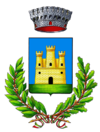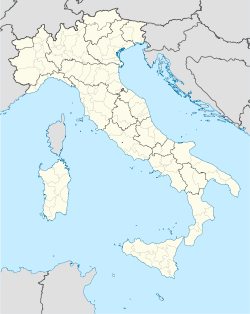- Corropoli
-
Corropoli — Comune — Comune di Corropoli 
Coat of armsLocation of Corropoli in Italy Coordinates: 42°49′N 13°50′E / 42.817°N 13.833°ECoordinates: 42°49′N 13°50′E / 42.817°N 13.833°E Country Italy Region Abruzzo Province Teramo (TE) Frazioni Accattapane, Centro Storico, Centurati, Colle Mejulano, Gabbiano, Montagnola, Pianagallo, Piane san Donato, Ravigliano, Ripoli, Vibrata Government - Mayor Paolo D'Aristotile Area - Total 21 km2 (8.1 sq mi) Elevation 132 m (433 ft) Population (January 31, 2006) - Total 4,195 - Density 199.8/km2 (517.4/sq mi) Demonym Corropolesi Time zone CET (UTC+1) - Summer (DST) CEST (UTC+2) Postal code 64013 Dialing code 0861 Patron saint St. Agnes of Rome Saint day January 21 Website Official website Corropoli is a town and comune in Teramo province in the Abruzzo region of eastern Italy. In recent years the town has had a population of just under four thousand individuals. The commune has approximately 1300 families and 1500 habitations. The gentilic for the town is corropolesi. Corropoli takes it name from the word "Ripoli", an ancient neolithic settlement located nearby. These ruins were discovered by Concezio Rosa, a physician from Corropoli, in the year 1871 The patron saint of Corropoli is Saint Agnes. The commune has a density of approximately 170 individual per square kilometer. The zip code for the town is 64013 and the phone prefix is 0861.
In the third century BC. the area of Corropoli came under Roman influence. The Romans constructed a good number of villas and temples in the area. Archaeological investigations conducted in the 1970s and 80's yielded a large number of Roman artifacts including dozens of terracotta pieces, amphora's, bowls, remains of villas. Atop these items were the remains of several more recent monasteries.
Between the years 1393 and 1760 Corropoli was one of the 19 dukedoms under the ruling Acquaviva family. It was given to them by King Ferrante in gratitude for the Acquaviva's assistance in defeating the attacks of the rulers of nearby Atri. Under Acquaviva rule Corropoli was greatly fortified. The reinforced city walls constructed at this time were built as protection for the baronial castle of the Acquaviva's. The castle had a torture room, vast wine cellars and stall for approximately 40 horses.
For many years there has been a strong religious presence in the town. Present are the Abbey of Santa Maria di Mejulano (also known as "la Badia"), the monastery of Gabbiano, and, from a later period, the parish churches of Saint Agnes, the convent of Saint Mary of the Angels, the church of Saint Joseph and the church of Saint Donato.
One important medieval structure is the Torre Campanaria di Corropoli (Belltower of Corropoli), which today is considered the city's symbol. The tower was designed by Antonio da Lodi and was erected towards the end of the fifteenth century. It makes up one of four "fratelli" (brother or cohort) towers located in the province of Teramo, the others being located in the towns of Teramo, Atri and Campli.
In 528 Corropoli was ceded to Dorotea Gonzaga, Marchesa of Bitonto. In 1541 Dorotea Gonzaga gifted Corropoli and other nearby lands to her nephew Baldassarre Acquaviva. In 1694 Corropoli was part of the holdings of princess Francesca Caracciolo, wife of Giosia of Acquaviva, who had left it to her as a gift. Corropoli remained in the hands of the Acquaviva family through the year 1760 when the last of the family owners, Isabella Strozzi, passed away. .
After the demise of the Acquaviva's, the baronial caste was demolished and space was made for the Piazza Pie' di Corte ("Piazza at the foot of the Court" in reference to the location at the foot of the Acquaviva compound). Visitors from all over the world travel to Corropoli to witness the splendor of this magnificent location.
Famous citizens include:
- Adolfo Borgognoni (1840–1893) writer
- Italo Foschi (1884–1949) sportsman and fascist, founder of the A.S. Roma
- Gaeteno D'Aristotile (1901–1985) physician, dialectical poet and man of great culture
- Emanuele Scaramazza (1957-). Contemporary painter whose works are known for their powerful emotive and visual impact. A major theme of Scaramazza's paintings is the search for a sense of equilibrium.
In the summer Corropoli hosts a number of exhibitions and fairs. One goes by the name Palio delle botti and another is known as "Agosto a Corropoli" (August in Corropoli). In years past Corropoli has hosted folk festivals as well as international woman's volleyball championships. A popular event held in August of year is the "Mostra-Mercato degli Hobby, dell'Artigianato e dei Piatti Tipici" (Hobby, Artisan and Culinary Fair). A great number of stands are set up showcasing the local food delicacies as well as hand made goods produced by local vendors and hobbyists.
Towns adjacent to Corropoli include Alba Adriatica, Colonnella, Controguerra, Nereto, Sant'Omero, and Tortoreto.
In Corropoli was created A.S.Roma football team in 1927, approved the same year in Rome from the Fascist Regime.
Abruzzo · Comuni of the Province of Teramo Alba Adriatica · Ancarano · Arsita · Atri · Basciano · Bellante · Bisenti · Campli · Canzano · Castel Castagna · Castellalto · Castelli · Castiglione Messer Raimondo · Castilenti · Cellino Attanasio · Cermignano · Civitella del Tronto · Colledara · Colonnella · Controguerra · Corropoli · Cortino · Crognaleto · Fano Adriano · Giulianova · Isola del Gran Sasso d’Italia · Martinsicuro · Montefino · Montorio al Vomano · Morro d'Oro · Mosciano Sant'Angelo · Nereto · Notaresco · Penna Sant'Andrea · Pietracamela · Pineto · Rocca Santa Maria · Roseto degli Abruzzi · Sant'Egidio alla Vibrata · Sant'Omero · Silvi · Teramo · Torano Nuovo · Torricella Sicura · Tortoreto · Tossicia · Valle CastellanaCategories:- Cities and towns in Abruzzo
- Communes of the Province of Teramo
Wikimedia Foundation. 2010.

